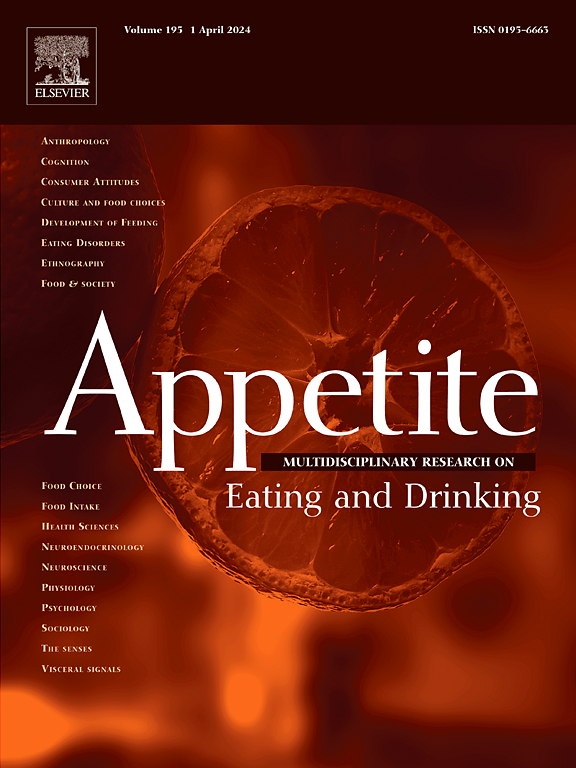不同的目标如何驱动注意力:关于父母的喂养目标如何影响对儿童目标食品包装线索的评估的访谈研究。
IF 4.6
2区 医学
Q1 BEHAVIORAL SCIENCES
引用次数: 0
摘要
在为孩子选择零食时,父母会接触到许多以儿童为目标的食品包装提示。本研究旨在了解父母的不同喂养目标(如健康、趣味和口味)如何促使他们关注这些提示,以及这些提示如何帮助父母做出不同的零食选择。本研究对 20 位父母进行了定性访谈,他们至少有一个 3 至 12 岁的孩子。在访谈过程中,我们向家长提出了不同的喂养目标,并要求他们根据这些目标对七种零食包装进行排序。访谈揭示了家长如何从目标角度考虑零食包装的三个重要启示。首先,当不同的喂养目标突出时,对包装提示的理解(和使用)也不同。其次,当包装提示不能为基于目标的评估提供有价值的信息时,这些提示就会被忽略。第三,在结合目标时,家长要么寻找符合其多重目标的线索组合,要么根据目标的逐步实施来评估包装,要么选择一个主要目标并依靠相关包装线索来对零食包装进行排序。这项研究拓宽了人们对父母的喂养目标如何影响他们对食品包装的选择以及他们解读包装线索的方式的认识。这项研究可以为政策制定者提供策略启发,激励营销人员通过引导消费者选择健康食品,并在购买零食的环境(如超市)中使这些选择更加突出,从而使食品环境更加健康。本文章由计算机程序翻译,如有差异,请以英文原文为准。
How different goals drive attention: An interview study on how parental feeding goals influence the assessment of child-targeted food packaging cues
When making snack choices for children, parents are exposed to many child-targeted food packaging cues. This study aims to understand how different parental feeding goals (e.g. health versus fun versus taste) drive attention to these cues and how these cues help parents to make different snack choices. Qualitative interviews were conducted with 20 parents with at least one child between the ages of 3 and 12 years old. During the interviews, parents were primed with different feeding goals and asked to rank seven snack packages based on these goals. The interviews revealed three key takeaways regarding how parents consider snack packaging from a goal perspective. Firstly, packaging cues are interpreted (and thus used) differently when different feeding goals are salient. Secondly, cues are ignored when they do not offer valuable information for making goal-based assessments. Thirdly, when combining goals, parents either look for a combination of cues that fit their multiple goals, assess packaging based on a stepwise implementation of goals, or choose one dominant goal and rely on relevant packaging cues to rank snack packaging. This study widens the knowledge on how parental feeding goals can influence the food packaging choices parents make and the way in which they interpret packaging cues. The study can inspire policymakers by providing strategies to stimulate marketers to make the food environment healthier by steering consumers towards healthy food options and making these options more salient within environments where snacks are bought (e.g. supermarkets).
求助全文
通过发布文献求助,成功后即可免费获取论文全文。
去求助
来源期刊

Appetite
医学-行为科学
CiteScore
9.10
自引率
11.10%
发文量
566
审稿时长
13.4 weeks
期刊介绍:
Appetite is an international research journal specializing in cultural, social, psychological, sensory and physiological influences on the selection and intake of foods and drinks. It covers normal and disordered eating and drinking and welcomes studies of both human and non-human animal behaviour toward food. Appetite publishes research reports, reviews and commentaries. Thematic special issues appear regularly. From time to time the journal carries abstracts from professional meetings. Submissions to Appetite are expected to be based primarily on observations directly related to the selection and intake of foods and drinks; papers that are primarily focused on topics such as nutrition or obesity will not be considered unless they specifically make a novel scientific contribution to the understanding of appetite in line with the journal's aims and scope.
 求助内容:
求助内容: 应助结果提醒方式:
应助结果提醒方式:


